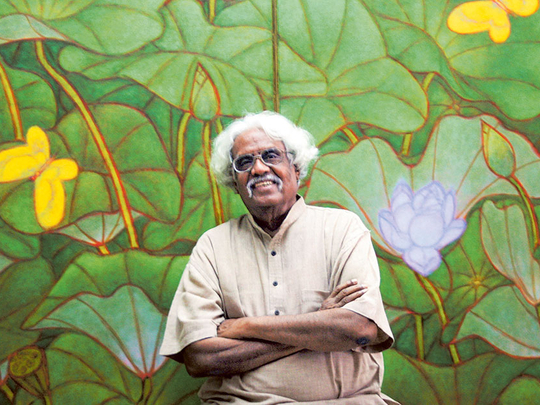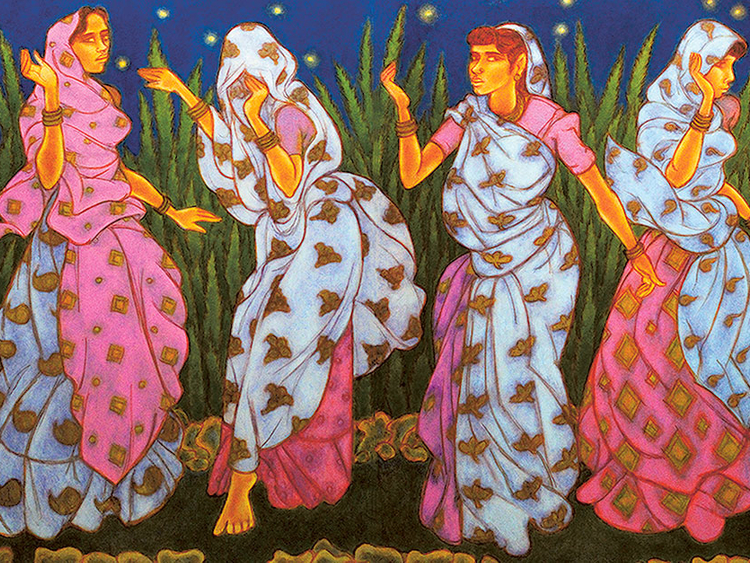
Achuthan Ramachandran, popularly known as A. Ramachandran, began painting as a child. Now, 80 years old, he still draws every day. “Drawing is an integral part of my daily ritual,” he says. “It’s just like a musician having to string the tanpura every day to do his riyaaz. I need to draw.”
His two-week, two-part exhibition opened at the Lalit Kala Akademi, New Delhi, on November 12. While he has done more than 5,000 drawings in the past 56 years, the exhibition showcases 1,500 selected works.
The first part, “A Retrospective: Drawings, Sketches and Studies 1958-2014”, is structured chronologically and thematically. The second part, “Ekalinji Fantasy”, holds 11 large oil paintings and bronze sculptures from 2009-2014. The exhibition traces the artist’s journey of creative expression based on observations and influences from life experiences.
Born in Attingal, Kerala, in 1935, Ramachandran developed an interest in the arts, including painting, music and literature, at an early age. He learnt Carnatic music for ten years and established himself as a professional singer before turning a painter. He also completed his masters in Malayalam literature from Kerala University in 1957.
His experience of the local landscape sensitised him to the beauty of nature, which, for him, was undiluted art. The murals, which he saw in the light of flickering lamps during his evening visits to the local temple with his mother, made him understand that art transcends the real. The first award he received for painting was six solid strokes on his bottom, he recalls, “when I broke open the cupboard, took out my elder brother’s coveted colour box and painted on a canvas”.
This minor aberration in childhood led to greater achievements later. He left Kerala in 1957 and joined Kala Bhavana at Visva Bharati University (founded by Nobel laureate Rabindranath Tagore in Shanti Niketan, West Bengal), where he was awarded a diploma in fine arts and crafts in 1961.
The cultural and intellectual milieu of Shanti Niketan drew him closer to the art traditions of India and other eastern civilisations, and Ramachandran began his lifelong research and completed a PhD in mural paintings of Kerala. As a related subject he studied miniatures and soon developed a style of his own.
In 1964, he moved to Delhi, where he now lives in his self-designed house at the Bharti Artists Colony in the Nirman Vihar area. In 1965, he joined Jamia Milia Islamia University, New Delhi, as a lecturer in art education.
Since 1966, when his first solo exhibition was held at Kumar Gallery in New Delhi, Ramachandran has held several one-man shows. Many of his works are abroad — hanging on American, German, Australian and English walls. When he entered the field, in the Sixties, the buyers were mostly foreign diplomats in the country. “It was very rare that an Indian would come to the exhibitions,” he says.
With his distinctive style and versatility, Ramachandran’s stature as an artist grew with each exhibition. His works began to be shown internationally and within a short span, he was known as one of the most original Indian artists of his generation.
“In traditional Indian schools, there was a system of observing and sketching from nature and transforming them in purely pictorial motifs,” he says.
During the Seventies, he developed into a versatile artist doing oil paintings, miniature paintings, ink and water-colour drawings, graphics, stamps, ceramics and sculptures. Apart from wielding the brush, Ramachandran also illustrated and wrote children’s books.
He worked at Jamia Milia for 28 years and, along with his colleagues, set up a fully fledged faculty of art, before taking voluntary retirement from teaching in 1992 to devote time to his other creative pursuits.
His best critic is his wife Chameli, also a painter. Chameli is of Chinese origin and was born in 1940 at Shanti Niketan. Her father, Professor Tan Yun Shan, came to India in 1928 to teach Chinese language and culture as part of Tagore’s efforts to facilitate an exchange of different Eastern philosophies.
Ramachandran likes working on large formats — 16 feet x 7 feet — that take up to four years to complete. Some of his largest works include a 60 feet x 8 feet canvas that he painted in 1986. Having seen it in its initial stage of workmanship, theatre doyen Ebrahim Alkazi then commissioned it.
Here is what else Ramachandran told Weekend Review during an interview:
What do you wish to convey to young artists through this exhibition?
I have studied nature and derived it all from nature and created a style. My idea is that beauty is inherent. It does not lie in copying the modern ways. For instance, the animal is happiest in its natural habitat. And there’s a lot of difference between a tiger in the zoo and a tiger in the forest. So, we should develop a visual culture, which should become an integral part of our inherent culture. I observe people in their natural surroundings and portray them in their natural ways along with nature. After seeing a lotus pond, I recreate it according to the requirement of the painting.
Do you still travel to paint?
Oh, yes, I usually go to Udaipur in Rajasthan and my basic source of material comes from a few nearby villages. The beauty lies in their fantastic landscape, water bodies and hills, and on the top of the hills are the ruins of ancient temples. The place serves as my headquarters for five-six days at least three to four times a year.
What do you sketch on your visits?
I sketch what I see, but in the process of sketching, I change it according to my own specifications. I also do on-the-spot sketches of children, which takes about 15 minutes each. They pose for me and young girls are especially happy to do so when they are wearing a new ribbon, bangles or earrings! In fact, the book “Face to Face”, published sometime ago, contains my photographic records in different places and settings.
In today’s world, which is influenced by technology and global cultures, how do you view contemporary art with respect to the art of your times?
I don’t see much of contemporary art, so I cannot really compare the two. Nowadays art is created on computers, which is fine. But the object lacks the intimacy and feel. Creating art on computer is like touching someone with a stick, as the touch of the fingers is missing. But then it depends on what one prefers. The choice is of the person, whether he wants to see the photograph of a beautiful girl or marry her!
One of the recent Bollywood films was on the life of Raja Ravi Varma, who is said to be the first modern Indian painter. What’s your take on it, since you’ve been his great admirer?
I cannot comment on the film as I have not seen it. But I recall having organised an exhibition of his paintings in 1994. I was then chairman of Lalit Kala Academy, Kerala, and wanted to showcase artists from the state at the all-India level. Ravi Varma was very popular when he was alive, but his popularity began to wane after his death. So, when I put up the exhibition, several Indian artists said it was mediocre art and should not be put up as a major show. My aim of putting up the show was to revive his art. But the realism of his works was seen as derivative, inspired by Western academic sources, and artists, especially of the Bengal school, protested. Although it’s true that he used European techniques to paint Indian gods and goddesses to make them look like ordinary people, there’s no doubt that he was one of the most popular artists India has ever produced. He was a genius in his own way. And, of course, after the exhibition, his price shot up by millions of rupees.
Nilima Pathak is a journalist based in New Delhi.
BOX
Ramachandran’s glittering career
• The National Award in 1969 and 1972.
• Noma Concours for Picture Book Illustrations in 1978 and 1980.
• Parishad Samman from the Sahitya Kala Parishad in 1991.
• The Gagan-Abani Puraskar from Visva Bharati in 2000.
• The Manaviyam Award from the Government of Kerala in 2001.
• The Raja Ravi Verma Puraskar from the Government of Kerala in 2003.
• Fellow of National Lalit Kala Akademi in 2002.
• Professor Emeritus at Jamia Milia Islamia University in 2002.
• Padma Bhushan from the Government of India in 2005.













